#sci fi biology
Text
Chiss Blue: An Update
Featuring everyone’s favorite bird, the blue-footed booby!

I’ve previously discussed how blue occurs in nature, and the Chiss! However my friend pointed out that I’d missed a very important example, that being the blue-footed booby, with their glorious blue feet and beaks.
(Not so long but long enough):
Blue-footed boobies get their coloration from their diet of fresh fish, which includes carotenoid pigments. Carotenoids are pigments produced mainly by plants and algae that are then absorbed by animals that consume them: flamingos, shrimp, salmon, and lobsters are all colored by carotenoids from their diets. Carotenoids can produce different colors depending on their chemical structure, and while yellow, orange, and red are more common, they also produce the blue in blue-footed boobies.
Carotenoids provide a number of benefits, including boosting the immune system. The color of a blue-footed booby is a display of their health: healthy, well-fed birds have a more vibrant color, which dulls with age and poor nutrition. Both females and males use the color to evaluate prospective mates.
To bring this back around to the Chiss, carotenoid pigmentation would raise some interesting questions regarding Chiss within the wider galaxy: do they have specific dietary requirements in order to get enough carotenoids? Does their diet consist mainly of fish, or do they get the carotenoids elsewhere? Is that why Thrawn was so pale in Rebels?
Either way, the good news is that carotenoids may provide some protection from the sun! So their blue skin might protect the Chiss from nasty sunburns - probably quite necessary if they’re spending time on the surface of a sunny planet covered in reflective ice and snow.
#a followup on chiss biology#chiss biology#sci fi biology#research#chiss skin#blue skin#star wars#chiss headcanons#thrawn#blue color#rebels#chiss sunburns#blue footed booby#pigmentation#enjoy :)
77 notes
·
View notes
Photo
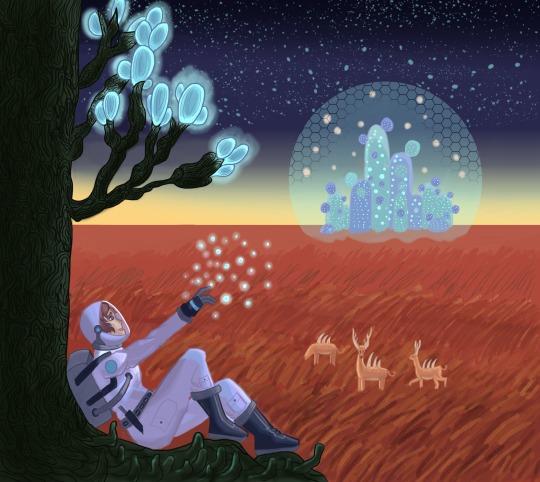
We love an alien ecosystem in this house. We also love giving deer spine spikes to defend against big birds and making fungi trees will bioluminescent spore pods. Image Id under keep reading.
Image Id: An astronaut in a pale blue space suit sits beneath a dark green tree with heavily textured bark. At its base, same green shoots point up towards the astronaut and the branches which have glowing oblong blue pods at their tips. The astronaut has black boots, pants with pockets on inner and outer calf and thigh, and a gray belt with many pouches. Attached to the belt is a knife in a black sheath. She wears a gray oxygen tank like a backpack and gray tube threads into a hole on the chest of her suit. Her helmet screws into her suit in a gray ring at the neck. It is stylized with an ear level blue circle that is surrounded by a gray ring with a stem that connects to a triangle at the based of the helmet. There’s a blue patch on her shoulder. Brown hair frames her smiling face, eyes wide with delight and wonder. She reaches with a black glove with gray bending fingers and a blue stripe across the back towards blue floating glowing spores. The background is a field of red grass beneath a dark blue sky with a flush of yellow at the bottom. The blue is filled with stars the same color as the spores. A herd of strange deer with spines on their back graze in the distance. One looks at the camera. One walks towards the left. One eats with its head buried in the grass. Beneath the stars their is a city of green and blue cylindrical buildings with rounded tops and spherical protrusions. The lights in the windows are blue like the spores and stars. Orange lights hover in the sky. A translucent blue dome with a hexagonal pattern near the top surrounds the city. /End Id
#alien#alien ecosystem#speculative ecology#speculative zoology#speculative biology#alien ecology#speculative architecture#sci fi#sci fi city#sci fi ecosystem#sci fi biology#astronaut#alien planet#space exploration#krita artist#speculative art#art#artists on tumblr#digital art#digitalartist#krita art
21 notes
·
View notes
Text
Oh yeah bc Altas Soldatins, including Kyle, have certain organs that are synthetic(usually the heart, kidneys and/or liver)they have this sort of milky green, almost white colored blood, which is also commonly used in people who have similar/a lot of cybernetics along w most if not all human manufactured synthetic organisms!! It looks like this btw :3

#world building#sci fi worldbuilding#sci fi universe#cyberpunk aesthetic#cyberpunk world#sci fi sona#my sona#sona talk#sona: kyle#sona lore#Sona biology#sci fi biology#cybers uploads
2 notes
·
View notes
Text

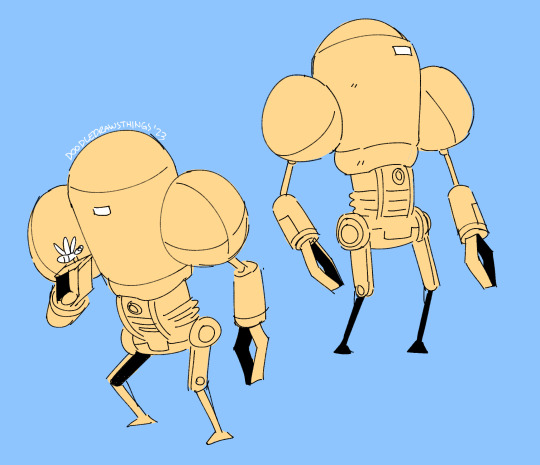
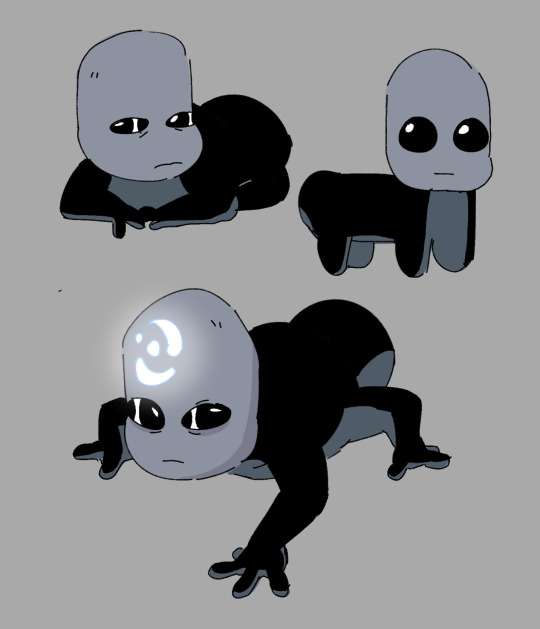
Scavengers Reign warmup fan art
#scavengers reign#fan art#animation#speculative biology#mak's art#creatures#i'm having a real normal one about this show#begging on my hands and knees for people to watch this show i need the work that has gone into it to be appreciated#if you like body horror and speculative biology and sci-fi you will adore it
2K notes
·
View notes
Text

Industrial light ⚙
An experiment I made to see if I haven't forgotten how to make illustrations in my style.
Also it represents tovoxran cities' vibe and aesthetic (idk if it's cringe to use that word or not), basically steel beams, gears, metal scaffoldings and pipes everywhere. Just industrialism and utility.
The drawing itself is showing a heat generator in one of underground tovoxran cities on Tillturn (their homeworld). In the past they used to build their cities around active volcanoes or lava lakes for heat, because the whole cave system is cold, covered in ice and snow. Now they can build everywhere, as their technology allows that.
#myart#alien#alien species#original alien species#sci fi#science fiction#industrialism#illustration#speculative evolution#speculative biology#spec evo#spec bio#creature#creature design#worldbuilding#tovoxrans
671 notes
·
View notes
Text
pen n marker world stave critters. Still need a name for the second one
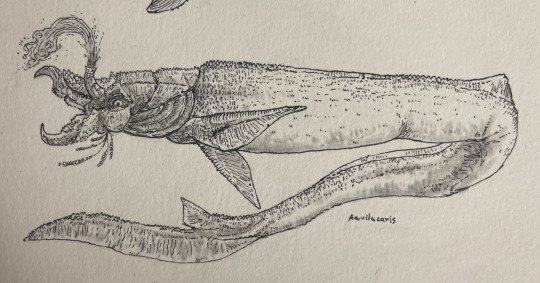

583 notes
·
View notes
Text

Here's what utiks look like outside their shell. Just little brains in jars, workin robots. It was all they could do for themselves in their scramble for self-preservation.
They are able to survive outside their suits for around 12 hours, as it's usually long enough for the fallen being's comrades to come to their aid and be placed in a life-support pod until another mech body is provided. The small brains are also capable of sight, though very limited. As like starfish, utiks have small "eyes" at the end of each limbs.
They have a slimy texture similar to jellyfish as they constantly secrete a layer of slime to protect their sensitive skin. The slime which the rakii would harvest. However, they are never to directly harvest the slime from the utik's bodies, as they risk harming the individual. Along with some mild ethical concerns. Instead, they pull the wiggly pilots from their beds and vacuum the leftover substance from there.
Another neat feature is the utik are capable of regeneration. As long as proper mass is still intact, the individual could potentially grow back as good as new. However, they are basically walking brains, as depending on damage, they may temporarily lose certain bodily functions, or worse, memory.
156 notes
·
View notes
Text
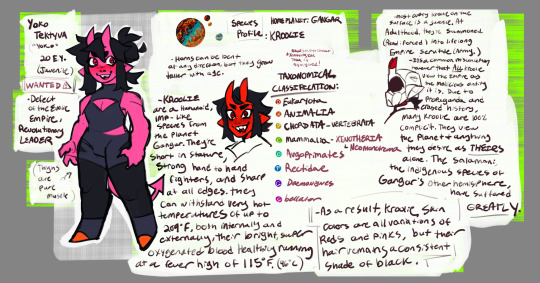
I wanted to flex my creative muscles a little bit by doing a silly lil species guide for one of my aliens in Lupus Automata, so I chose Yoko as my subject! Setter of fires eater of soap love of my life
GRAHHH I LOVE SPECULATIVE XENOBIOLOGY
174 notes
·
View notes
Text


CM KOSEMAN, SPEC-EVO ARTIST OF SINAD AND ALL TOMORROWS IS DOING ART COMMISSIONS!!
THIS IS NOT A DRILL!

#ITS HAPPENING!!#cm kosemen#art commissions#all tomorrows#Sci fi#Sci fi art#creature design#spec evo#speculative evolution#speculative biology#speculative fiction
287 notes
·
View notes
Text
You have been approached by a Dog
Your actions:
A) pet the Dog
B) give the Dog your sandwich
C) shoot the Dog

D̵̨̨̘̰̭̤̪̹͈̥̲̞̱̹͈̻̓̾͗̚͠ǫ̴̨̢͖̻̤̠͕̮̗̭͎̹̺̦̣̗̲͔̗̭̼̏̒g̸̨̨̨̛̳̦͙̘̗͉̻̬̬̹̝̙̫͙͔̦̠̰̲͔̓͋̄̈́͋́͌̉̉͛͛͒͋͗̕͘͘͠ͅͅ
#remotusverse#art#my art#sci fi#speculative zoology#speculative biology#alien#speculative evolution#speculative species#Dog
1K notes
·
View notes
Text
On Creature Design
Artists and writers often don't realize the full range of variety that animals include. This leads to "aliens" that are a lot less alien than a lot of creatures on Earth.
Imagine that you are designing an imaginary animal to go on an alien planet in a fictional universe. We'll suppose for this example that your creature fits the Earth definition of "animal." What might this creature be like?
Here's just some of the traits that "animals" in fiction are usually assumed to have...that real animals often don't have:
The ability to move around: To be fair, most animals have a motile phase of their life cycle, but many animals, such as corals, (most) sponges, and (most) bryozoans, don't move as "adults."
Bilateral symmetry: that is, there's a left and a right side that mostly mirror each other. Humans are bilaterally symmetrical. But not all animals are. Take starfish for example. They have radial symmetry instead.
Either an herbivorous or a carnivorous lifestyle: The natural world...actually isn't divided into predators and prey. Don't forget the detritivores!
The ability to make that one specific roaring sound that every single alien and dinosaur makes in a movie: Animals make some WEIRD fucking sounds okay. Y'all ever heard a blue jay making its "swinging gate" impression?
Size comparable to horses, cattle, and humans: It's weird to think about, but humans are megafauna. We're enormous compared to most insects, worms, birds, and even rodents and bats, the largest groups of mammals. The "average" animal is closer to a bee than a human. A lot of sci-fi beasts and monsters are the size of a rhino, but try going outside on Earth—you'll encounter a thousand much smaller organisms before you find one that large. A planet that is otherwise "Earth-like" would probably be similar.
Individuality or "Individual" lifestyle and consciousness: Yes, yes, I know the "hive mind" is a trope, but it's often still assumed that "animals" are individual units independent from one another, where each "individual" has a complete set of all the organs and features it needs to survive. However, some real animals, like siphonophores and, yes, bryozoans, are colonial—their "individuals" are modules that can't live independently, rather like organs in an animal like a human. Because I can't stop myself from talking about bryozoans...in Selenaria bryozoans, the "individuals" around the outside edge of their colony use their setae as legs to walk around, and the other individuals provide the "legs" with food, since they can't eat by themselves. Bryozoan colonies are also interconnected by a linked nervous system, and sometimes colonies that grow into each other will just...merge, and start sharing their nervous system even though they're genetically different. Science.
Adaptations to full time life on land: Water worlds and sea creatures are not exactly missing in scifi, but it's still under-acknowledged that land life is a weird adaptation to a weird extreme environment. Land animals are just water animals that have learned to carry around their own water inside them. It's true! Living in water is so much simpler, because you can always just filter particles out of the water around you to eat, and when you need to reproduce you can just throw some gametes out there so somebody will find them.
"Male" and "female" individuals: Stories that mess with this generally have a MORE rigid biological "caste system" with more categories, but there are a lot of animals that can reproduce sexually or asexually at their whim, that change sex as part of their maturation process or when conditions require it, or that switch freely between producing sperm and egg cells. "The females are larger and more dominant!" isn't even that weird or unusual. Try "every member of this species is "male" when they are younger and becomes "female" later in life" or "this alien decides whether to be "male" or "female" depending on what the situation requires" or "these aliens are engaging in ritual combat with their dicks to see who gets pregnant." You know. Normal stuff like that.
3K notes
·
View notes
Text
Some thoughts on Iridescence!
Following up on my musings on insects and Nuso Esva, let’s talk about iridescence! That cool shiny thing bugs (like Esva) have going on, as well as birds, fish, and some minerals. Iridescence is usually produced by microstructures that reflect different light frequencies at different angles – basically, the microscopic-level structures of the bird feather/ fish scale/ insect carapace reflect off each other to alter the light frequency, which produces different colors at different angles.
Iridescence has evolved in multiple species for multiple reasons. It can be useful for communication between individuals, finding mates, as a territorial signal, for group movements like flocking or schooling, to avoid predators through mimicry or camouflage, confuse predators, or warn of toxicity.
Furthermore, it may be a simple side effect of structures useful for friction reduction in burrowing organisms, water repellency, to strengthen tissues, enhance vision in eyes, or possibly for thermoregulation.
While I find the idea that there’s something preying on Nuso Esva’s people with enough success to cause a full-body evolutionary response… concerning, I could definitely see it as a form of communication – either to see each other, since they do seem to work together, and identify each other among strangers, or to be attractive. Bonus points if it’s also the result of a stronger carapace!
#iridescence#sci fi biology#nuso esva#star wars biology#star wars#really wish we had a species for him#bug biology#bug boy
13 notes
·
View notes
Text
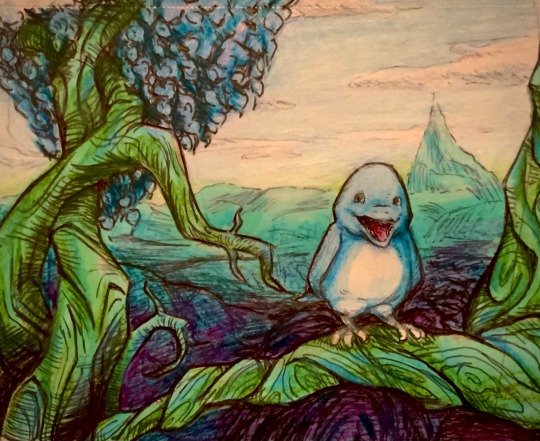

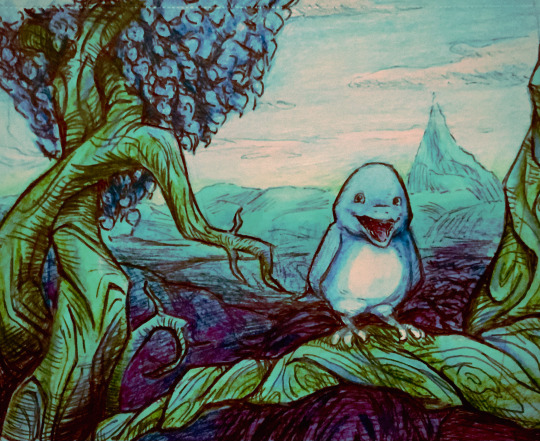
Fin fin redraw of one of the official screenshots I think
#my art#fanart#doodle#fin fin#rtvs#alien planet#sci fi#speculative biology#idk which version is the best it was on paper w pencil colours n biro so it photographs like doodoo#traditional art
208 notes
·
View notes
Text




The River Jordan and Sweetpea are electric engines on the first railway on Mars.
River Jordan was the first one built, being the product of a collaboration between the nations who established the colony.
Sweetpea was donated by a coronal aerospace guild and assembled onsite. Her parts were imported and her blueprints were crownmade, so her visage is coronal.
Visage and the nature of living transport
Engines take the image of their creators. Their faces are not organic, and are more like a vessel for helpful senses and communication tools.
They come alive soon after they are built, once out of eyeshot for any moment. Attempts to stare at a new engine to see it stir are foiled somehow (blinks, saccades, CCTV malfunction, momentary lapse in attention). Not all engines come alive, as their animacy is often (but not always) decided by the intent of the builder.
Living engines can assess their circumstances and make judgements based on them. They are useful in volatile situations as an expert second opinion on conduct and design, and are capable of sensing external and internal problems quickly.
In calmer periods, they may not get adequate stimulation, and their personalities may interfere with their efficiency. For this reason, railways have their preferences when they build and purchase engines.
The facial material ends at the surface of the machine and is inscrutable in composition—the material appears to be made of itself, and is unusable for any other purpose besides as an engine’s interface with the world. If damaged, the material heals. If removed, it disappears. The conceptual self-referentiality of engines’ faces, souls, and senses deter scrutiny.
Living machines exist as a fact of the universe. Their animacy is cloaked in an analysis-averting antimeme.
Human Engines
Engines designed and built by humans possess dual-pinhole pupils that dilate into an elliptical shape, granting them a broad field of view and tolerance of rapid changes in light levels (such as in going in and out of tunnels). Deep set zygomata allow them to look directly to their sides, and with the dual-pinhole setup, they maintain some depth perception in monocular sight. Their pupil shapes are hidden by their black irises, which absorb glare. They can see clearly to their front and sides, but can’t see up or down very well. A tapetum lucidum retroreflects incoming light back through their retinas, granting them vision in darkness. The nictitating membranes and long eyelashes protect the eyes from dust.
The chemicals engines are capable of detecting are relevant to their purpose, e.g. distinguishing coal, gasoline, diesel, and wood fires from their smoke but not being able to distinguish or detect food smells. Similar to how cats, obligate carnivores, have lost their ability to taste sugar due to its absence in their diet, but can taste ATP for its presence in meat—engines can parse environmental and industrial scents, but will have wildly varied responses to food and fragrant compounds, often being unable to notice them.
To investigate an aroma, they slightly lower their bottom lip to take air into their vomeronasal organ located behind the upper incisors.
Engines do not require oxygen, but if debris enters the nasal passage, human engines will sneeze to:
Ensure their voice resonates properly,
Keep their olfactory facilities clean, and
Indicate to engineers that particle buildup may have occurred in other places, such as the boiler tubes for steam engines.
Crown Engines
Just as the tongue is the only colored object on a human engine’s face for distinguishability, so are the teeth on coronal engines. The positions of the upper and lower jaw indicate tone, functioning in communication similarly to eyebrows.
Coronal engine eyes consist of an armored cornea surrounded by a cuticle and muscular eyelid. The cornea moves with the help of the embedded eyestalk supporting it. The cuticle is lubricated with an oil-based film and is less susceptible to irritation than the aqueous solution on human engine eyes. The undersides of the eyelids and surface of the cornea are covered in setae, preventing chafing and reducing airflow on the cornea. The hairs catch debris and are combed out by the lids with a puckering motion.
To make up for unenhanced vision by human engine standards, coronal engine hearing is advanced, allowing the listener to pinpoint sound sources through triangulation of the four inner ears. Coronal engines, too, channel sound through their incisors and into their internal ears via the acoustic windows at the hinge of each jaw.
Coronal engines achieve their sense of industrial smell through the gustatory papillae that line their choana and pharynx. They supplement their olfaction by introducing cool air behind the heat pits inside their nares.
Coronal engines’ thermoception is more efficient than living crowns, as coronal engines’ faces do not produce heat nearly proportional to their mass.
Conversely, the tines heat up significantly hotter than the crown average for unambiguity in temperature tones. The origin of the tine thermal energy appears to be redirected from excess produced by the machinery, or from the face’s temperature directly.
Extramodal senses
Engines are capable of listening from within their cabs with greater acuity than mere conduction of sound through the body would suggest. Other unsubstantiated sensory abilities include:
Discernment of water/fuel quality within the framework of taste though intake alone
Somatosensory awareness in the entire body, not just the face
#BOA#the railway series#<- my cover all tag#the river jordan#sweetpea#crowns#my art#speculative biology#This is an AU of my sci fi story#thomas and friends
415 notes
·
View notes
Text
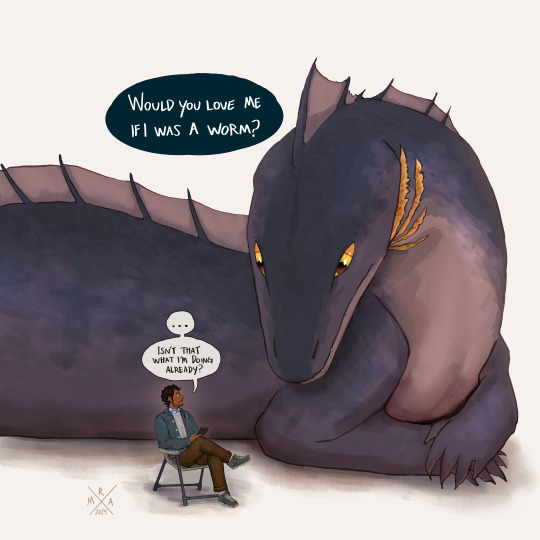
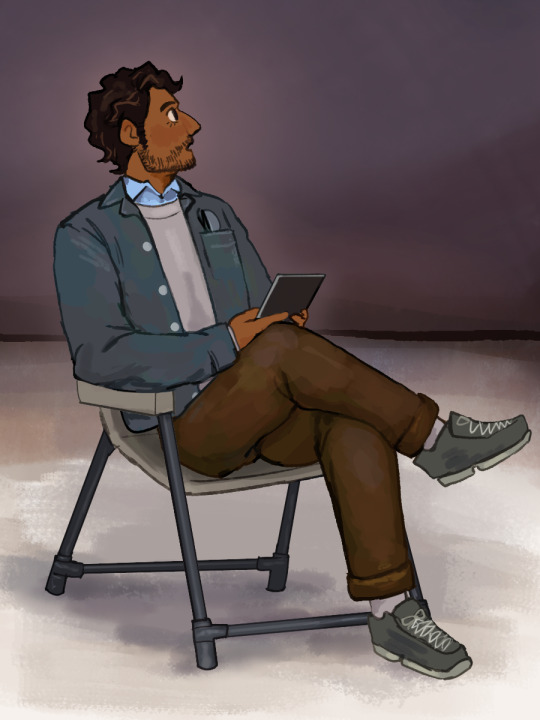

Continuing the tradition of Nishant and Nameless to start the year. Little late but eh it's still January
These two have existed since about 2013 but changed a lot since. Most notably, Nameless started out as a ‘demon’ who could change shapes from a human to a creature like the one he looks like here.
Nishant has always been an academic though. He's the wrong person to ask this question, he's a microbiologist. His job is loving worms
#speculative biology#alien#alien design#science fiction#rainmaker#nishant#nameless#nameless is softly smiling in this btw. gills out and no teeth. relaxed smile#mine#rex#OCs#sci fi art#ignore this next tag#terato
115 notes
·
View notes
Text

A daily reminder how tovoxran toothing looks like <3
#myart#alien#alien species#original alien species#sci fi#science fiction#worldbuilding#speculative evolution#speculative biology#xenobiology#spec bio#spec evo#creature design#creature#monster design#alien design
445 notes
·
View notes